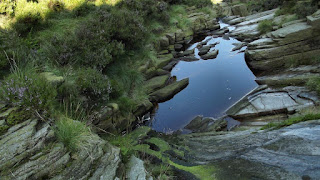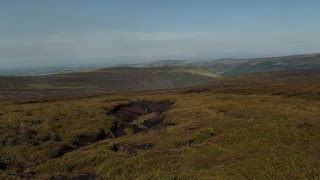Situated right along Torside Reservoir in the Peak District, Wildboar Clough is a popular Grade 2 scramble. I’ve heard it can be quite dangerous in the wet, so waited for an extended dry period before giving it a try. The descriptions I’m giving are of how tackled the crux sections, routes and techniques I chose to use. If you have limited experience I would advise going on a course. I’ve had some rock climbing experience and this comes in handy on tougher sections. Smart people walk away from something they don’t think they can do, especially when serious injury would be the result.
My morning out started at the car park a kilometre or so from Torside Clough. Heading north east along the Longdendale Trail from the car park it’s around a quarter of a mile to the sign for Wildboar Clough.
The path takes you along the edge of a woodland, and up to the fence just below Rollick Stones where you cross the stile.
Once across the stile keep to the path along the edge of the gully until it eventually drops down into the Clough.
The scramble begins as a basic boulder field and introduces you to Peak District gritstone which generally has a good grip level unless it is particularly green or mossy.
The boulders start to get bigger and the incline steeper.
Then you come to a warm up section for what is to come later. This is the first of the vertical sections, and on Wildboar Clough there are nearly a dozen ranging from around 5 feet to over 15 feet. My choice was to tackle the pile of boulders to the left of the green face.
The next, larger climb involves a rather graceless shuffle up the Trapezium shaped rock with the slightly curved top on the middle-left of the photograph. It feels exposed with your right leg dangling into nothing, but a few shuffles and the use of hand holds at the top and you are up.
The next section is my favourite and feels like a mini rock face. The crack straight up the centre offers excellent foot holds with plenty of options for the hands in and around the crack.
This next section is the most well known section of Wildboar Clough. I had expected to edge around this one, but although the primary route was in poor condition I did find an alternative. But first of all I had to scramble up the initial triple step onto a lower ledge.
Once onto the lower ledge above the triple step I then headed up to the section on the right where the rocks have become a little rounded. Even so, they offered fair grip and allowed easy access up onto the upper ledge.
Once on the upper ledge I stopped for a break and a reccy around the area. There is a bit of a pond here and you have to watch you don’t end up with wet feet. But there is enough room for a few people to make a pit stop.
While I looked around I stepped up onto a smaller ledge at the back of this larger ledge. The standard route off to the right was extremely mossy and slippery, so I looked further. Then I noticed a chimney off to the left. Not literally a chimney like in a house, but a narrow rock cleft.
“Chimney: A rock cleft with vertical sides mostly parallel, large enough to fit the climber's body into. To climb such a structure, the climber often uses his head, back and feet to apply opposite pressure on the vertical walls.” (Wikipedia)
In this case the chimney was too small for any kind of fancy climbing techniques, like Chimneying (you can look this one up), but does offer a large number of foot holds and hand holds, if it is a little slimy in places. In any case, it was far less exposed than the standard route, and will still maintain the grade 2 difficulty.
Once on top of this section I turned round and was able to get some nice photos, including a better view of the gunk on the top third of the corner section I bypassed, and glad I did. One slip and it’s good night Vienna.
Watch a video of Wildboar Clough and you’ll possibly be lead to believe that the large waterfall is the final challenge Wildboar Clough has to offer, it’s not. I found that there were, what I thought, more technically challenging scrambles to come.
The next section used a bit of Bridging(also known as Stemming) and a the liberal use of some shuffling until I was able to get a hand under me. I basically scrambled up and onto the boulders on the right of the very mossy waterfall section. It was a bit unorthodox at times, but I got up there. It probably looked funny from below the waterfall, but if it works…….
The next stepped section is more a case of keeping an eye on where you put your feet to make sure you don’t slip. A slip here could potentially be very dangerous.
The next section called for a little more bridging and stretching for hand holds up on the top.
An easier section came up with a fairly step up on the left side, always keeping away from the mossy areas that could be quite dangerous even if only a few feet high.
This, almost final scramble, was probably the most physically difficult as hand holds were tough to find. If you are in a group it would be quite easy to give someone a leg up, but for a real challenge its better if someone just spots for you so you can face the challenge head on. Some careful foot placement allows you (I’m 5 foot 10 inches tall) to just reach a crack at the back of the ledge.
Just past the previous challenge is a slopped slab section that was so slippery I had to edge around it. The rock steps level out into an incredibly picturesque gully that is worth the hard work on its own.
You arrive at a final rock section that brings you up and onto the moor above.
My return route was to be along the Pennine Way along Clough Edge above Torside Clough.
Following a heading of around 190 degrees from the top of the Clough though Sykes Moore I found myself heading eventually downhill with Torside Castle in view. I’ve been in this area quite a few times and knew that the point where the Pennine Way cuts east along Wildboar Grain was around a hundred meters or so off to the left of the path to Torside Castle.
So I continued on my heading and found myself dropping down into the top of Torside Clough to the Pennine Way…..result.
I had chosen a fabulous day for this adventure. The sky was virtually cloudless above me and the SPF 50 sun screen was in use. I have a large skin graft on my right arm that puts me in a high risk skin cancer group. I saw people up there without hats, in vests, and no protection. Don’t take chances with the sun.
This was my first grade 2 scramble, and hands down the best so far. The challenges were a little hair raising at times, keeping me on my toes. But the experience is hard to beat. This will not be my last visit to Wildboar Clough.
And as a final note, they are removing the Pylons from Woodhead Pass...brilliant! (Edit: No they aren't, unfortunately. I had heard a rumour that it was planned, but to my disappointment, they are doing refurbishment work on the existing pylons. Oh well, I can hope.)
References:
Wikipedia, Glossary of climbing terms, viewed August 13th 2015, <https://en.wikipedia.org/wiki/Glossary_of_climbing_terms>
Wikipedia, Glossary of climbing terms, viewed August 13th 2015, <https://en.wikipedia.org/wiki/Glossary_of_climbing_terms>



































No comments:
Post a Comment